
The Cuban Missile Crisis stands as one of the most perilous moments in the history of the Cold War, bringing the United States and the Soviet Union to the brink of nuclear conflict. This tense 13-day standoff in October 1962 between the world's two superpowers was triggered by the Soviet installation of nuclear missiles in Cuba, just 90 miles from the shores of the United States.
The roots of the crisis trace back to the earlier part of the decade. The 1959 Cuban Revolution, led by Fidel Castro, resulted in the overthrow of the Batista regime, which had been friendly to US interests. Castro's subsequent nationalization of American-owned properties and businesses, along with his open alignment with the Soviet Union, led to deteriorating relations with the United States. In response, the US implemented a series of economic sanctions against Cuba and even sponsored a failed attempt to overthrow Castro during the Bay of Pigs invasion in 1961.
The Soviet Union, led by Premier Nikita Khrushchev, saw an opportunity to strengthen its global strategic position and to secure an ally in the western hemisphere by placing nuclear missiles in Cuba. These missiles would significantly alter the strategic balance of power, as they could easily reach most major US cities. In September 1962, Soviet ships carrying nuclear warheads and missile equipment began arriving in Cuba, a move that was initially undetected by the US.
The discovery of the missile installations was made on October 14, 1962, by a US U-2 spy plane. Photographs taken during the flight provided irrefutable evidence that medium-range and intermediate-range ballistic missile sites were being constructed in Cuba. President John F. Kennedy was informed of the situation two days later, which marked the official start of the crisis. The President convened a group of his closest advisors, known as the Executive Committee of the National Security Council (ExComm), to discuss the US response.
Kennedy decided against immediate military strikes against Cuba, which could potentially provoke a full-scale nuclear war. Instead, he chose to impose a naval blockade, or "quarantine," to prevent further Soviet missiles from reaching Cuba. On October 22, Kennedy publicly revealed the existence of the missile sites to the American public and the world, announcing the US decision to surround Cuba with naval vessels. He demanded the removal of the missiles and the destruction of the sites.
In the days that followed, the world watched anxiously as the situation escalated, with Soviet ships approaching the quarantine line and US forces preparing for a possible invasion of Cuba. The crisis peaked on October 27, when an American U-2 spy plane was shot down over Cuba, and a US invasion seemed imminent.
A critical turn of events came with a letter from Khrushchev to Kennedy, proposing that the Soviet Union would dismantle its missile installations in Cuba in exchange for a US promise not to invade the island. A subsequent secret agreement also led to the removal of US Jupiter missiles from Turkey, which had been another major concern for the Soviets.
Finally, on October 28, Khrushchev announced that he had ordered the removal of the Soviet missiles in Cuba, effectively ending the crisis. The resolution of the Cuban Missile Crisis is often seen as a turning point in the Cold War, leading to a period of détente, or easing of tensions, between the two superpowers. This included the establishment of a direct communication line between Washington and Moscow, known as the "hotline," to help prevent future crises.
The Cuban Missile Crisis demonstrated the potential devastation of nuclear war and highlighted the importance of diplomacy and communication in international relations. It left a lasting impact on all parties involved and significantly influenced public and governmental perceptions of nuclear weapons and their use in global politics. The crisis not only marked one of the closest points to nuclear conflict during the Cold War but also set the stage for future arms control agreements and a gradual thaw in US-Soviet relations until the eventual dissolution of the Soviet Union in 1991.